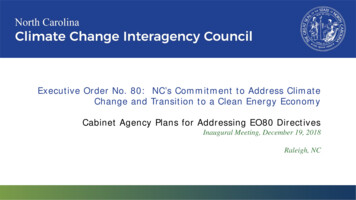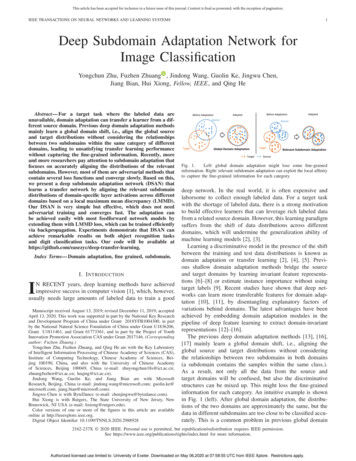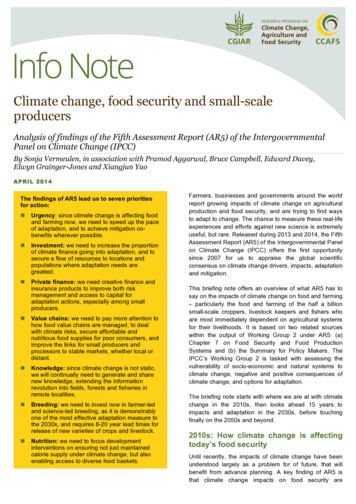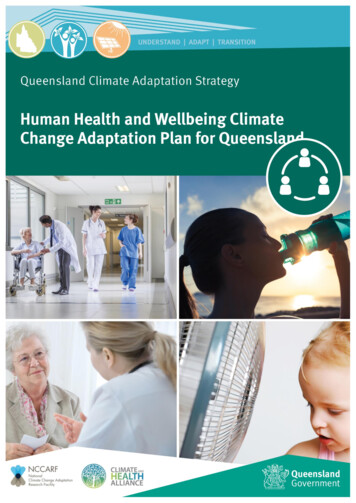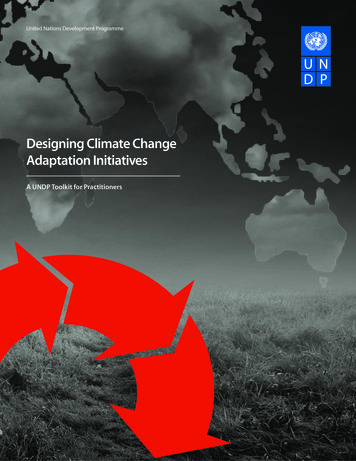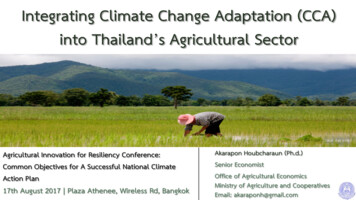
Transcription
Downloaded from orbit.dtu.dk on: Jul 01, 2022Evaluating climate change adaptation options for urban flooding in Copenhagen basedon new highend emission scenario simulationsArnbjerg-Nielsen, Karsten; Leonhardsen, Lykke; Madsen, HenrikPublished in:Clima change adaptation adapting to change: from research to decision-makingPublication date:2014Document VersionPublisher's PDF, also known as Version of recordLink back to DTU OrbitCitation (APA):Arnbjerg-Nielsen, K., Leonhardsen, L., & Madsen, H. (2014). Evaluating climate change adaptation options forurban flooding in Copenhagen based on new highend emission scenario simulations. In Clima changeadaptation adapting to change: from research to decision-making: Abstracts (pp. 47).General rightsCopyright and moral rights for the publications made accessible in the public portal are retained by the authors and/or other copyrightowners and it is a condition of accessing publications that users recognise and abide by the legal requirements associated with these rights. Users may download and print one copy of any publication from the public portal for the purpose of private study or research. You may not further distribute the material or use it for any profit-making activity or commercial gain You may freely distribute the URL identifying the publication in the public portalIf you believe that this document breaches copyright please contact us providing details, and we will remove access to the work immediatelyand investigate your claim.
Abstracts
Third Nordic International Conference on Climate Change Adaptation, Copenhagen 2014Table of contentsTable of contents . 2Program . 9Opening plenary .15The Working Group II Contribution to the IPCC 5th Assessment Report . 16Helsinki 2012: Adaptation research met adaptation decision‐making ? what emerged?. 17Plenary ‐ IPCC AR5; so what now? .19Keynote . 20Climate Change 2013: The Physical Science Basis ‐ Highlights from the latest IPCC report . 21Policy‐making for an uncertain future . 22Monday session ‐ IPCC AR5; so what now?.23Developing the skill of multi‐annual climate prediction . 24Improved regional scale projections using integrated climate and hydrology modelling. 25Projecting precipitation intensities in Scandinavia under a changing climate . 26Nordic collaboration within Climate Services . 27Monday session ‐ Mainstreaming .28Communicating and visualising climate projections – user preferences and abilities amongstadaptation practitioners in local authorities in Germany. 29A quantitative assessment of the effectiveness of climate change communication in promotingengagement with adaptation . 31Climate adaptation and institutional change in Norwegian stormwater management . 32Adapting to changing floods: the role of the norwegian centre for climate services in transitioningresearch to operation . 33Innovations in weather and climate services ? Analysis of key technological and social factorsshaping the future adaptation capability. 34Monday session – Limits and opportunities .35Tailoring climate services for impact challenges in municipalities in Northern Norway . 36Serving adaptation through innovation in weather and climate services . 37Adressing the climate adaptation deficit through geographic visualization . 39Effective climate change risk communication . 40Remote sensing estimates of impervious surfaces for pluvial flood modelling . 41Special session: Centre for Regional Change in the Earth System .42Centre for Regional Change in the Earth System: models, uncertainties, effects and adaptation . 432
Third Nordic International Conference on Climate Change Adaptation, Copenhagen 2014Risk Based Approach to the Assessment of Economic Consequences of High End Climate Scenarios– Methodological Framework and Application to Urban Flooding . 44Evaluating the future impacts on Odense catchment under climate and land use change . 45A model validation framework for climate change projection and impact assessment . 46Evaluating climate change adaptation options for urban flooding in Copenhagen based on newhigh‐end emission scenario simulations . 47Plenary – Limits and oppertunities .48Limits and Opportunities of Climate Change Adaptation . 49Climate change as a driver for paradigm change in urban water management . 50Climate‐KIC and lessons learned so far . 51Tuesday session 1 – IPCC AR5; so what now? .52Ten years of implementing regional climate service . 53The rebound‐ effect: A useful concept in the climate discourse? . 54The challenge of mainstreaming climate change adaptation actions of Nordic insurers . 55Climate predictability beyond traditional climate models . 56Multi‐model Combination of Statistically Downscaled RCM Projections . 57Tuesday session 1 ‐ Mainstreaming .58Control Station 2015 ‐ Swedish Adaptation to Climate Change . 59A climate adaptation strategy for the Baltic Sea Region . 60The 2nd Generation National Adaptation Strategy ? Improvement or Regression to the Mean?. 61Localizing the Governance of Climate Change. 62Climateadaptation.eu: connecting science and end‐users on climate adaptation across Europe . 63Tuesday session 1 – Low probability / high impact .64Sustainable primary production in a changing climate ‐ effects to barley and oilseed rape from thefuture climate. 65Climatic changes of extreme precipitation in Denmark from 1874 to 2100 . 66Mapping future flooding hazards from sea extremes and subsidence . 67A decision‐making framework for flood risk management based on a Bayesian Influence Diagram. 68Special session: Impacts of climate change on Nordic Primary Industries .69Effects of climate on fish, fishery and economics ‐ Experiences from the CLIFFIMA network. 70Challenges for Nordic livestock production and the role of farm animal genetic resources inclimate change adaptation . 71Fish in warmer waters: the case of the Arctic char . 72Nordic forest soil carbon storage and sinks ‐ controlling factors and management . 733
Third Nordic International Conference on Climate Change Adaptation, Copenhagen 2014Mitigating the risk of snow mould damage in high yielding grass species adapted for futureclimate. 74Plenary ‐ Mainstreaming .75Towards a climate‐proofed future . 76Design Principles for Governance Arrangements for Climate Adaptation . 77What can journalism do? News Media Contributions to Citizens’ Understanding of Climate Change. 78Tuesday session 2 – IPCC AR5; so what now? .79Adaptation to climate change in West‐Africa ‐ The experience of ACCIC, a regional projectsupported by DANIDA to support the adaptation in the region . 80Learning from extreme weather events in German utilities: how sensemaking influences privateadaptation . 82The Green Climate Fund: UN Climate Change Conference Delegates? Perspectives onCapitalization and Balanced Allocation Between Adaptation and Mitigation. 83Some advanced in adapting water resources management to climate change in Quebec (Canada). 84Climate change adaptation in the transport sector: The Nordic Experience . 85Tuesday session 2 ‐ Mainstreaming .86Waters with(out) Borders ? The Matter of Decentralisation on Climate Change Adaptation inNorth Denmark . 87Using and visualising climate projections for adaptation planning in local government in the UK – auser study of adaptation . 88Farmers as water managers ‐ extreme runoff and adaptation options in rural areas . 90Flood compensation in the Nordic countries ‐ changing flood regimes and compensation systems. 91VisAdapt: development and evaluation of an adaptation decision‐making tool for homeowners . 92Tuesday session 2 – Limits and opportunities .93Towards a climate secured Scania . 95Towards Water Sensitive Cities of Sweden, The Necessity for re‐thinking the way we plan ourcities . 96Sharing adaptation knowledge and experiences to overcome barriers and seize opportunities?workshops as a successful learning‐tool to progress in adaptation . 98Political climate adaptation decisions in Germany from an economic point of view ‐ shortfalls andpossible applications for decision support systems. 100Risk Assessment and Regional Action Plans ‐ Guidance for Climate Change Adaption in Sweden 101Tuesday session 2 – Low probability / high impacts . 1024
Third Nordic International Conference on Climate Change Adaptation, Copenhagen 2014The perceived need to adapt to climate change in a natural resource dependent community inNorthern Norway . 103Does publishing of flood risk maps have the intended effects? . 104Assessing limits of adaptation for ecosystem services under a changing climate in Finland . 105Climate model uncertainty versus conceptual geological uncertainty in hydrological modelling . 106Investing in climate change adaptation: understanding risk when facing an uncertain future . 107Tuesday session 3 – IPCC AR5; so what now? . 108Adapting to mitigation policies: Farming in Northern Norway . 109Modelling linkages between adaptation and mitigation in the agricultural sector in the Nordicregion to inform policy making for effective adaptation . 110Bioenergy trade in a changing climate: identifying and adapting to climate vulnerable supplychains . 111Climate‐smart cities as catalysts for sustainability: A new look at synthesized adaptation &mitigation planning approaches to climate change. 112Climate change adaptation in the energy sector: an interview study in European companies andpublic organisations . 113Tuesday session 3a ‐ Mainstreaming . 114Supporting cities to adapt to climate change by using a modular toolkit ‐ first results and lessonslearnt . 115Climate change adaptation of buildings in Norway. Risks, consequences, measures and futureresearch. . 116Management, improvement and prevention of flooding of the state roads ‐ a strategy in action117Are Danish Homeowners Ready to Engage in Integrated Urban Stormwater Management? . 118Adaptation to climate change in the German railway system: the interplay between actors andinstitutions . 119Tuesday session 3b ‐ Mainstreaming . 120Identifying and assessing policy coherence in climate adaptation in Denmark, Finland andGermany. 121Integration of Climate Adaptation Policy across levels of policy making and the adaptive capacityof local government in Denmark . 123Indicators to monitor climate change adaptation: an approach and lessons from Scotland. 124National adaptation policy processes across Europe . 125Database support systems for adaptation to climate change: an assessment of web‐based portalsacross scales . 127Tuesday session 3 – Limits and oppertunities . 129Citizen valuations for climate change adaptation in three municipalities in southwestern Scania. 1305
Third Nordic International Conference on Climate Change Adaptation, Copenhagen 2014Influence of citizens and stakeholders in real‐life adaptation policy ‐ opportunities and barriers 131Taking science‐stakeholder cooperation one step further: Experiences from the Swedish forestsector . 132Regimes of value ‐ climate change adaptation and the handling of water in urban landscapes . 133Decision making in high‐stake, low‐probability climatic events Looking beyond standardeconomics to explain relevant behavioral anomalies . 134Plenary: Low probability / high impacts . 135Cool it: turning up the heat . 136Extreme weather events, high impacts and perceptions of change . 137Quantifying the human contributions to observed changes in precipitation extremes . 138Wednesday session – IPCC AR5; so what now? . 139Decisions and strategies in forestry related to weather extremes and climate change . 140Modelling framework of simulating every day storm water sewers and cloudburst green arearunoff . 141Climate change adaptation in the railway sector: an International Comparison . 142Environmental multi hazards from increased precipitation in coastal urban areas ‐ Knowledge foradapting without causing second consequences . 143Vulnerability of cross‐country skiing to climate change in Finland ‐ Interactive mapping tool . 144Wednesday session ‐ Mainstreaming . 145Government framings of climate change adaptation in three countries: steering insurance sectorapproaches . 146Climate‐related risk drivers and the private sector . 147A changing climate for business . 148The role of insurers in mainstreaming climate‐related actions . 149Wednesday session – Limits and oppertunities . 150Adaptation governance at the sub‐national level . 151What is worst: bad planning or bad weather? . 152Extracting causal linkages from a federated database of case studies . 153Optimal Decision Making, Adaptation to Climate Change in the Agricultural Sector. . 154Smart pre‐breeding of barley for a future climate with concurrent hazards . 155Special session: Managing climate change in Nordic cities – challenges of implementation . 156Climate Change Adaptation in Copenhagen ‐ from plan to implementation . 157Balancing between mitigation and adaptation in the City of Helsinki . 158Climate change adaptation from a planning theoretical perspective ? ambiguous legitimacy inHelsinki . 1596
Third Nordic International Conference on Climate Change Adaptation, Copenhagen 2014Risk, role and responsibility of home owners in climate change adaptation . 160Posters. 161Large‐scale hydrological simulations with the HYPE model: uncertainties in the simulated changesand the usability of the simulations in impact studies in the Scandinavian region. 162How climate change could affect future residential energy demand for space heating in the Nordiccountries? . 163Validation of two high‐resolution climate simulations over Scandinavia . 164Application of Next Generation Sequencing to predict the effects of climate change in the Arctic. 165The phylogeographic structure of Arctic char (Salvelinus alpinus); a candidate model species topredict the effects of climate change in the Arctic . 166Barriers and enabling factors of climate change adaptation and mitigation among Swedish forestowners . 167Building Resilient Regions Italian Adaptation to climate change, a multi‐level governanceprospective. 168Modeling climate change impact on early potato crop and the risk of frost damage in NorthernEurope . 169Quantifying and visualising agricultural vulnerability to climate change and variability in the Nordiccountries . 170Adaptation to climate change in energy sector in Ltavia . 171Air quality hazards under present and future climate in Bergen, Norway . 172Social Acceptability of Climate Change Adaptation in Farms and Food Enterprises ‐ a Case Study inFinland. 173High‐resolution regional climate services based on turbulence‐resolving simulations . 174Adaptation Strategies and Policy Coordination in EU Member States: A comparative perspective:. 175Towards an improved European Plant Germplasm System . 176Hazard and Risk Maps for the EU Floods Directive in Denmark . 177Investigating possibilities for climate change adaptation using local area recharge in urban areas. 178Urban Cloudburst Planning: Flexibility is key for robustness . 179Life Cycle Assessment as a decision support tool in policy making: the case study of Danish springbarley production in a changing climate. 180Costs and benefits of technologies for adaptation to climate change, examples from theagricultural and water sectors in Lebanon . 181Decision making in high‐stake, low‐probability climatic events Looking beyond standardeconomics to explain relevant behavioral anomalies . 1827
Third Nordic International Conference on Climate Change Adaptation, Copenhagen 2014The benefits of early warnings for food security: Case studies in Malawi and Zambia . 183Estimating the sowing date of spring crops in Finland based on temperature using Bayesianmethods . 185Remote sensing estimates of impervious surfaces for pluvial flood modelling . 186The climate change impact of a high‐end CO2‐emission scenario on hydrology . 187The Role of Citizens in Resilience to Climate Change ‐ A Review of Current Research . 1888
Third Nordic International Conference on Climate Change Adaptation, Copenhagen 2014ProgramSunday August 24 201418:00Reception & RegistrationMonday August 25 20148:00Registration10:00Refreshments10:30Opening plenaryWelcome / Jens Hesselbjerg ChristensenRasmus Helveg Petersen (Minister for Climate, Energy and Building, Denmark)Connie Hedegaard (Member of the European Commission)Chris Field (Co‐chair IPCC WG2)Timothy R. Carter (Finnish Environmental Institute) Beyond Helsinki 201212:00Lunch13:00Plenary ‐ Theme 1: IPCC AR5; so what now?Neil Strachan (IPCC WG3)Gian‐Kasper Plattner (IPCC WG1)Jane Ellis (Climate Change , OECD)14:00Refreshments14:30Theme 1: IPCC AR5;so what now?Theme 2:MainstreamingTheme 3: Limits andopportunitiesSpecial: Centre forRegional Change in theEarth SystemDeveloping the skill ofmulti‐annual climateprediction ‐ RalfDöscherCommunicating andvisualising climateprojections – assessmentof user preferences andabilities in Germany ‐Susanne LorenzTailoring climate servicesfor impact challenges inmunicipalities inNorthern Norway ‐ HansOlav HygenCentre for RegionalChange in the EarthSystem ‐ Jens HesselbjergChristensenImproved regional scaleprojections usingintegrated climate andhydrology modelling ‐Morten Andreas DahlLarsenA quantitative assessmentof the effectiveness ofclimate changecommunication inpromoting engagementwith adaptation‐Gregor VulturiusServing adaptationthrough innovation inweather and climateservices ‐ AdriaanPerrelsRisk Based Approach tothe Assessment ofEconomic Consequencesof High End ClimateScenarios –MethodologicalFramework andApplication to UrbanFlooding ‐ KirstenHalsnæs9
Third Nordic International Conference on Climate Change Adaptation, Copenhagen 2014Projecting precipitationintensities inScandinavia under achanging climate ‐Cathrine Fox MauleClimate adaptation andinstitutional change inNorwegian stormwatermanagement ‐ KyrreGrovenDecision support foradaptive action?Assessing the potential ofgeographic visualization ‐Anna BohmanEvaluating the futureimpacts on OdenseStream catchment underclimate and land usechange – Jørgen E. OlesenNordic collaborationwithin Climate Services ‐Eirik J. FørlandAdapting to changingfloods: The role of thenorwegian centre forclimate services intransitioning research tooperation ‐ Hege HisdalEffective climate changerisk
Third Nordic International Conference on Climate Change Adaptation, Copenhagen 2014 6 Influence of citizens and stakeholders in real‐life adaptation policy ‐ opportunities and barriers 131
